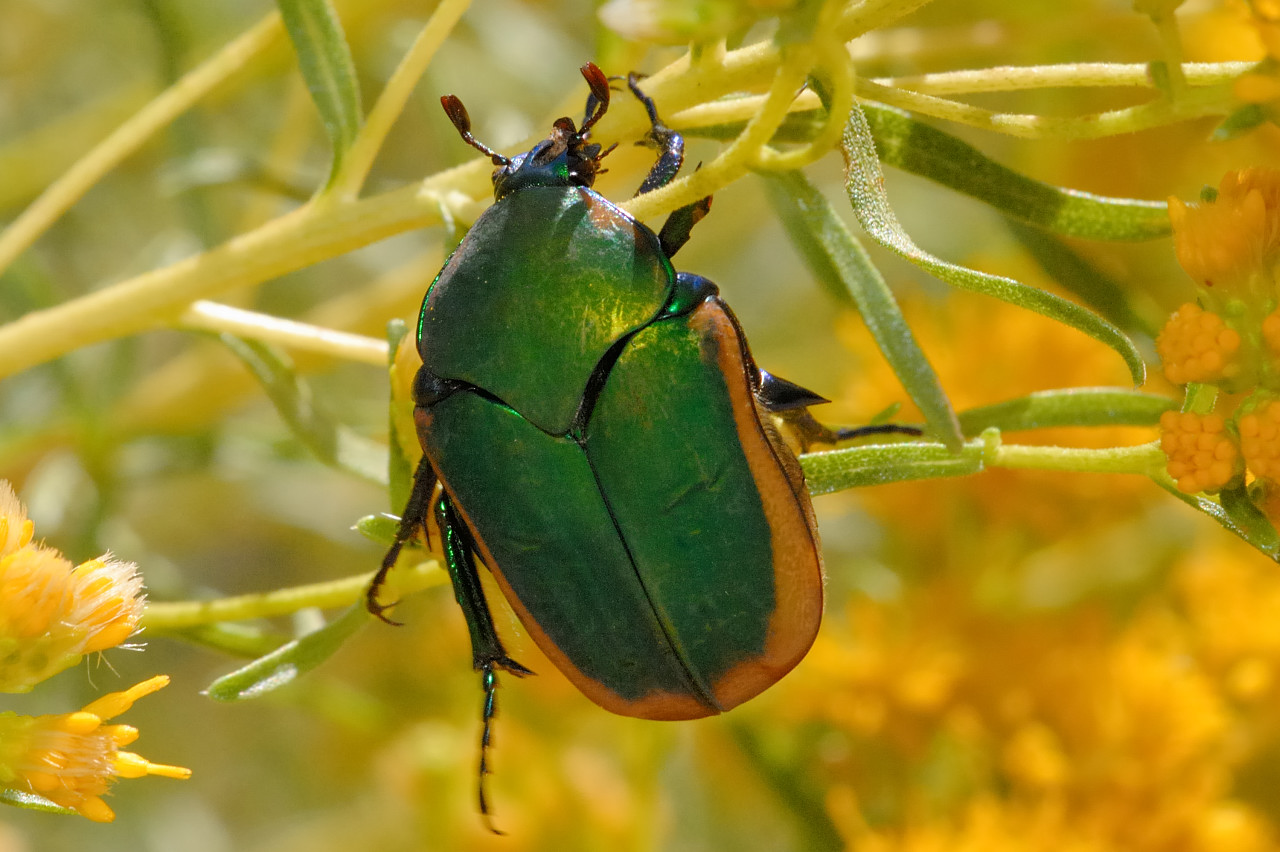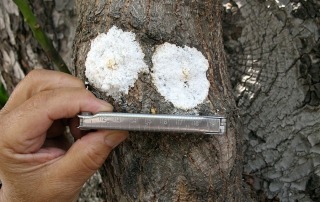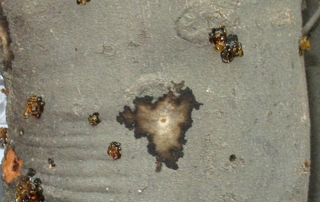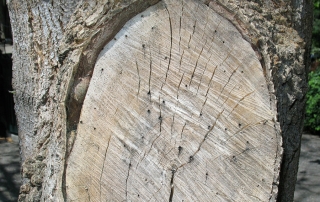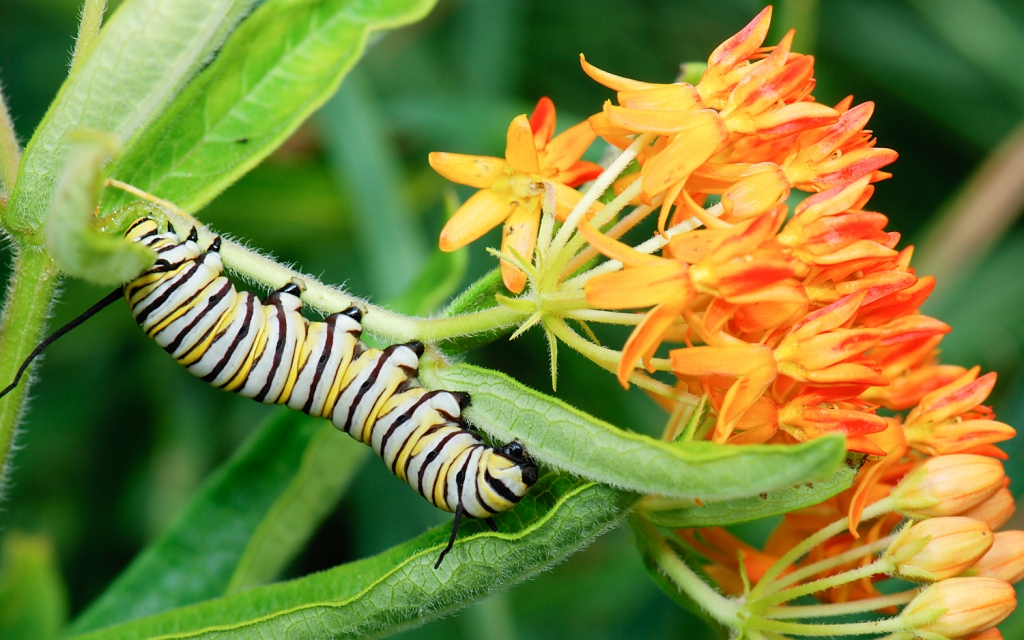INVERTEBRATES
The term Invertebrate refers to animals without backbones such as insects, spiders, worms, and snails. This section contains information on many of Los Angeles County’s most common invertebrate pests that injure landscape plants. An internet search using any of the scientific names provided will reveal a wealth of additional information including images. Can’t figure out what it is that’s causing the damage? The County Entomologist may be able to help. Refer to Appendix I for contact information and proper submission of specimens.
Insects
Beetles
Beetles and their larvae may feed on and damage a wide variety of landscape plants. Representatives of such families as Bostrichidae (false powderpost beetles), Buprestidae (metallic wood-boring beetles), Cerambycidae (longhorned beetles), Chrysomelidae (leaf beetles), Curculionidae (weevils), Scarabaeidae (scarab beetles), Scolytidae (bark and ambrosia beetles) are often leading the pest charts. Beetles may notch or chew holes in leaves, completely skeletonize foliage and lead to plant death. Some beetle families (Bostrichidae, Buprestidae, Cerambycidae, Curculionidae) tunnel in the inner bark of the trees killing branches and tops or girdle the cambium layer reaching the heartwood and creating extensive galleries.
These attacks may produce large amounts of sawdust, gumming and bleeding on trunks and branches and can result in dieback and structural weakening. Several representatives of Chrysomelidae, Scolytidae, and Curculionidae may vector injurious diseases that can seriously affect plants. Adults and larvae of some beetles may feed on the same host plant, but attack various parts of it. Good examples are weevils and scarab beetles where adults commonly feed on plant foliage and larvae attack roots.

(Left and Center) Damage produced by the Diaprepes Weevil. (Right) Adult Diaprepes Weevil.
Photo credit: Gevork Arakelian
Many pest species can be found in Los Angeles County including green fruit beetle (Cotinis mutabilis), ten-lined June beetles (Polyphylla spp.), common June beetles (genera Cyclocephala, Serica, Phobetus), bark beetles (genera Euwallacea, Dendroctonus, Ips, Monarthrum, Scolytus, Pityophthorus), Stout’s hardwood borer (Polycaon stoutii), diaprepes root weevil (Diaprepes abbreviatus), California prionus (Prionus californicus), eucalyptus longhorned beetles (Phoracantha spp.) and others.
Good cultural practices are recommended to maintain healthy plants. Stressed, slow growing or injured plants are particularly susceptible to attack by beetles and their larvae and may display lower survival rates. Infested plant parts often should be removed and properly disposed. Growing plants adequately adapted to the area is essential. Preserving natural enemies (assassin bugs, birds, checkered beetles, click beetles, flat bark beetles, lizards, robber flies, spiders, tachinid flies, braconid and ichneumonid wasps, etc.) is important for managing pest populations. There are several broad spectrum contact insecticides available, but the impact their use might have on natural insect predators must be carefully considered before they are used. If used, insecticides should be applied in the beginning states of infestation (early pest detection is critical); they may not be very effective when populations are high. Spraying plants during blooming season should be avoided due to its toxicity to honey bees and other pollinators.
Caterpillars (butterflies and moths)
Various caterpillars (larvae of butterflies and moths, order Lepidoptera) may injure landscape plants. They often chew large sections or skeletonize the leaves, produce silken tents or fold and create shelters on foliage. Some caterpillars bore in and damage branches, others feed on the roots of plants. Initial damage often may not be immediately recognizable. Early in the season, high numbers of caterpillars on young newly established trees and shrubs may seriously affect plants, leading to defoliation, branch dieback and death.
Several pest species are well known to residents of Los Angeles County.
Among the most noteworthy are California oakworm (Phryganidia californica), fruittree leafroller (Archips argyrospila), citrus leafminer (Phyllocnistis citrella), omnivorous looper (Sabulodes aegrotata), tent caterpillars (Malacosoma spp.), tussock moths (Orgyia spp.), imported cabbageworm (Pieris rapae), carpenterworm (Prionoxystus robiniae), owlet moths (Helicoverpa spp., Agrotis spp., Euxoa spp., Spodoptera spp.) and clearwing moths (Synanthedon spp., Paranthrene spp.).
Controlling caterpillar pests is often difficult. Depending on one type of control (biological, cultural, or chemical) is not as satisfactory as an integrated pest management program where several means of control are utilized. Larvae can be successfully treated by using the bacterium, Bacillus thuringiensis which is relatively safe to use around humans and pets. It is most effective when used against newly hatched larvae. Several broad-spectrum contact insecticides are also effective against caterpillar species. Unfortunately, these products often kill many beneficial invertebrates, which may lead to outbreaks of other destructive pests. Conservation of natural enemies (assassin bugs, bigeyed bugs, damsel bugs, birds, ground beetles, lizards, pirate bugs, spiders, various species of parasitic wasps, etc.) is very important since many caterpillars are often under effective biological control by various predators, parasites, viruses, etc.


